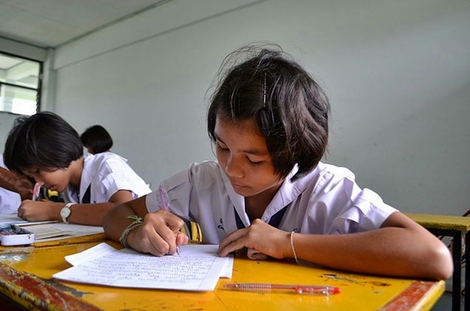How to Teach Critical Thinking to EFL Students in Asia
The first thing most new EFL teachers in Thailand discover when they begin to teach English is the lack of critical thinking skills of most Thai students.
Thailand, like many other countries in Asia, has a history of teaching students by rote. The teacher writes information on the board and the students copy it, memorize it and regurgitate it on the next exam. Consequently, many Asian students don’t have problem-solving or critical thinking skills, both of which are necessary if they are to compete in the modern world.
For any EFL teacher to be successful in Asia and to really help their students learn, they must teach critical thinking and problem solving skills, and here are some great ways to start.
Begin With Reading – When beginning to teach critical thinking skills to EFL students in Asia who don’t have them, you shouldn’t begin with something too challenging or something that requires them to bring their own already-though-out opinions or information to class.Instead, begin with a reading exercise. Read a passage in an English book out loud, then have your students read it out loud themselves. Then discuss it.
In Thailand, I usually use an article from a book of travel essays about Thailand written by westerners. It’s a subject students are familiar with and, because it’s about their own country, it’s easier to elicit opinions from them, as they often think the western author is wrong.
I always read part of the article to my students, then have them read it to me. Then I ask them several questions, such as – “Is this something you’ve experienced?”, “Do you think what the author says is correct and, if not, why not?”, “Do you think the author understands Thai culture?”, “What other things would you add to the article if you were writing it?”
Related: How to teach EFL students to write a persuasive letter or email — an easy lesson plan
Once I’ve done a reading discussion a few times, my Thai EFL students usually open up, have more and stronger opinions and really begin to think about what they’re hearing and reading. Once you’ve completed a few reading exercises and had success with several discussions, you can move on to something a little more challenging.
Simple Debate Skills – While a debate might seem like a huge challenge for EFL students just learning about critical thinking and problem solving I’ve often discovered, if it’s kept at a simple level and about a subject they’re interested in, it’s usually quite successful and students have a blast.
I teach high school students so, as a way to teach them critical thinking skills, I’ve chosen short debates about subjects like “Should teenagers be allowed to play computer games on weekdays?” and “Are Thai movie stars and singers good role models or not?” Because they’re subjects my students are interested in, at least 80% of the class will have a strong opinion and will begin to talk.
To encourage their critical thinking skills to develop, don’t just allow them to make a statement and leave it at that. As the moderator, the teacher should challenge their opinions and push them to think a little bit deeper. If it’s about a subject they’re passionate about, they often will.

Critical Thinking Skills in Writing – As critical thinking skills are vital at the university level in the west, and becoming more important in Asian universities, it’s important that Asian students can apply critical thinking and problem solving skills to essays they write.
I always begin by assigning a simple writing exercise. I put my students into pairs or groups and ask them a question like “When you’re 18, would you like to live like most western teens do, away from their parents, or do you want to live with your family like most Asians do and why?”
I then give the pairs or groups 10-15 minutes to brainstorm which way they would rather live and why. They must write down at least six things that back up their argument and be able to back it up further if, as the teacher, I challenge it.
My students love doing this as they don’t have to work alone and, with some students developing critical thinking skills faster than others, they often learn from each other as much as they learn from me.
Once I’ve done a couple of these fast critical thinking writing exercises, I then assign them an essay using the same technique – the essay must include at least 3-5 pieces of evidence or opinion to back up their argument.
Teaching critical thinking to EFL students in Asia is often as simple as asking your students what their opinions are and then pushing them on what they think so that they think deeper and their critical thinking skills become more developed.
Most students in Asia do have opinions and critical thinking skills, and can develop problem solving skills if the student themselves is treated as having something valuable to add to the discussion and is actually asked what their opinion is (in Asia, they’re usually not even asked).
In fact, I’ve had students say to me they don’t think they have critical thinking skills, then when I give them an example of what they’ve told me in an early class as being a perfect example of a “critical thinking skill” they’re surprised and, quite frankly, ecstatic as it’s often much easier than they think it is.
More Information:
How can we teach critical thinking skills? – ERIC Digest

